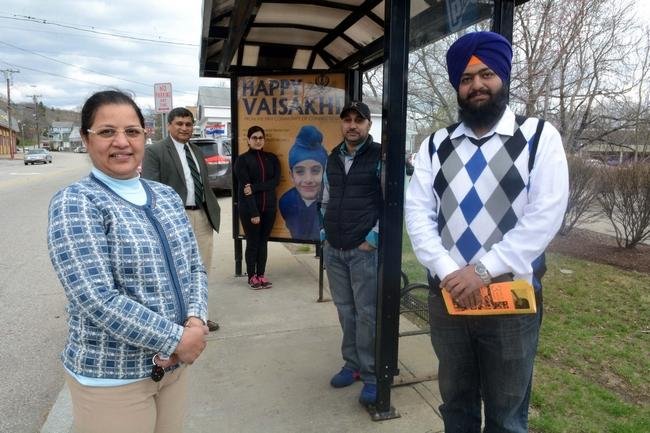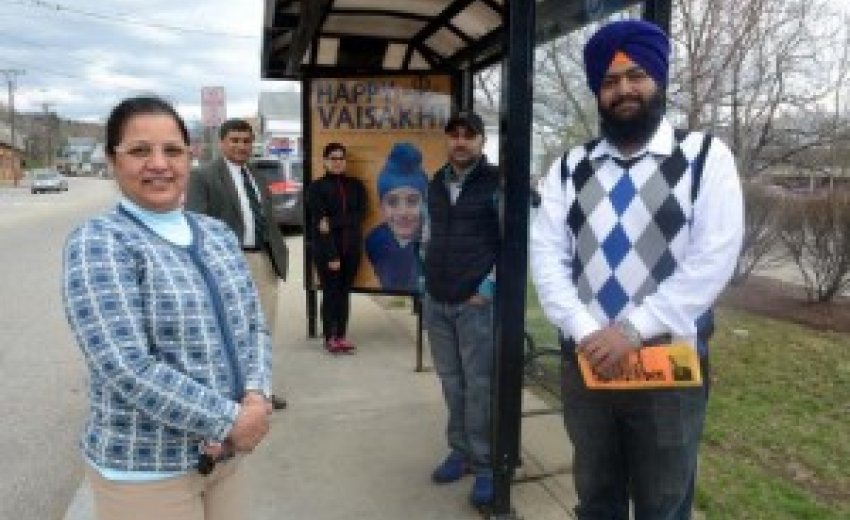 |
| From left, Dr. Mandeep Kaur, Dr. Raminder Walia, Guntas Kaur, Jaspal Singh Paul and Swarnjit Khalsa show one of the 10 signs that hang in the Norwich area to bring awareness to the Sikh community as they celebrate Vaisakhi. Aaron Flaum/ NorwichBulletin.com |
Apr. 26, 2015: NORWICH - Swaranjit Singh Khalsa and his wife, Guntas Kuar, were walking in Mohegan Park recently when a customer of his stopped and asked why he wore a turban and she did not.
“He said, ‘so you are more American? That’s mean. I'm not un-American because I tie a turban,” Singh Khalsa , 29, said.
They are Sikhs. So is Kuljit Singh, a store manager who has been mistaken for a Muslim.
Sikhism, the world’s fifth largest religion, requires baptized men to wear bright turbans every day to show self-respect, honor, piety and spirituality.
The men also are required to take the last name Singh.
“Sikhs are not different than any other American. They share the same values. This is part of our uniform,” said Khalsa, the 29-year-old owner of Norwichtown Shell Food Mart and convenience store.
To help educate people about his religion and raise awareness, he has helped organize a month-long initiative.
At 10 Southeast Area Transit District bus tops in Jewett City, Montville and Norwich, the Sikh Sevak Society has installed pictures of smiling people in turbans directing the public to a website where they can learn more.
Organizers launched the campaign April 6 and it runs through May 3 to coincide with Vaisakhi, the equivalent of April in the Sikh calendar.
It’s the second advertising blitz sponsored by Sikh Sivak, which last year purchased space on a billboard overlooking Interstate 84.
The point is to put a human face behind the public relations push, which is why many people taking part in the initiative have put “Happy Vaisakhi” lawn signs on their property and carry pamphlets and other literature explaining the principles of Sikhism.
A recent report by the National Sikh Campaign suggests such an effort is needed. According to its findings released in January, just one in 10 Americans know a Sikh personally, and 60 percent of all 1,114 people surveyed admitted to knowing nothing about the religion.
Further, an October 2013 analysis by the Sikh American Legal Defense and Education Fund found almost 49 percent of people believed the religion was an offshoot of Islam and blames media depictions of men in turbans for helping to spread misconceptions about the peace-based religion.
“Our main goal is to make our fellow Americans feel comfortable when they see turbaned Sikhs. They should know we are Sikhs and we have our distinct identity. They should know we are from Punjab state in India, and Sikhism is not a branch of any other religion,” Singh Khalsa said. “Lots of our people have had to go through racism.”
Despite a global population of 25 million, Sikhs make up about a tenth of 1 percent of the U.S. population – about 500,000. Yet since 9/11, they’ve been victims of high-profile hate crimes such as the Aug. 5, 2012, shooting at a Sikh temple in Oak Creek, Wis., that left six people dead. Just four days after the 2001 attacks, Balbir Singh Sodhi, who owned a gas station in Mesa, Ariz., was shot and killed, marking what officials believe is the first death in retaliation for 9/11.
But local leaders have been quick to embrace their Sikh brethren. Norwich officials declared last November “Sikh Awareness Month” and commemorated the 30th anniversary of a violent, months-long clash in India that led to the deaths of at least 2,800 Sikhs, though unofficial estimates put the number as high as 11,000.
Mayor Deb Hinchey attended the November event, and organizers rang the city’s Freedom Bell in remembrance of those killed.
Kuljit Singh, a manager at the Husky Spirit liquor store in Mansfield, said the high-profile approach behind this month’s initiative is necessary to draw as many people away from unhealthy stereotypes as possible.
“Most of my customers at first, they think I’m from an Arab country. Afghanistan or something. I ask them why and they say, ‘because you wear a turban,’” Singh, 35, said. “But people are happy to learn about it.”
Singh Khalsa’s wife, Guntas Kuar, came to Connecticut five years ago from Maryland. She said Singh’s turban has led to many conversations with people on the street.
“People are kind and some just are curious about where we’re from due to Singh’s turban. I have personally felt uncomfortable at times due to people being ignorant," Kuar said. "Once, I had a person who looked at me and went, “oh my God, you know how to speak English.’ I laughed it off and said, ‘welcome to America, lady.’”
